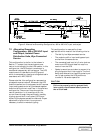
8 Installation Manual
Figure 1. Preferred Grounding Configuration, 480 or 600 VAC input and output
GROUNDING
ELECTRODE
PER NEC 250-24
7.1. Preferred Grounding Configuration,
480 or 600 VAC Input and Output,
Isolated Power Distribution Units,
Wye-Connected Service
One of the most-common configurations of the
Series 600T UPS is the Single Module System with
480 VAC input, 480 VAC output, and a connected
load consisting of multiple Power Distribution
Units (PDUs) with isolation transformers in the
PDUs to produce 208 VAC. For Canadian
customers, the UPS modules usually have 600 VAC
input and output. The same principles apply if the
connected load is an isolation transformer feeding
various loads. Figure 1 above shows a typical
installation.
Notice that the UPS module main input and
bypass input are connected to a grounded-wye
service. In this configuration, the UPS module is
not considered a separately derived source. The
UPS module output neutral is solidly connected to
the building service neutral, which is bonded to the
grounding conductor at the service entrance
equipment
The isolation transformers in the PDUs are
considered a separately derived source. Therefore
the PDU neutral should be bonded to the PDU
grounding conductor and connected to a local
grounding electrode in compliance with NEC 250-
26.
Advantages of this configuration include:
• A measure of common-mode noise attenua-
tion, since the isolation (common-mode rejec-
tion) occurs as close to the load as practical
(i.e. at the PDU).
• The UPS module can be located remotely
from the PDU without compromising com-
mon-mode noise performance.
• By using UPS modules with 480 VAC input
and output and creating 208 VAC at the PDU,
smaller and less costly power feeders can be
used and less voltage drop (as a percent of
nominal) occurs.
NOTE
Impedance-grounded wye sources must be
grounded in accordance with Section 7.5.
DISCONTINUED
PRODUCT


















